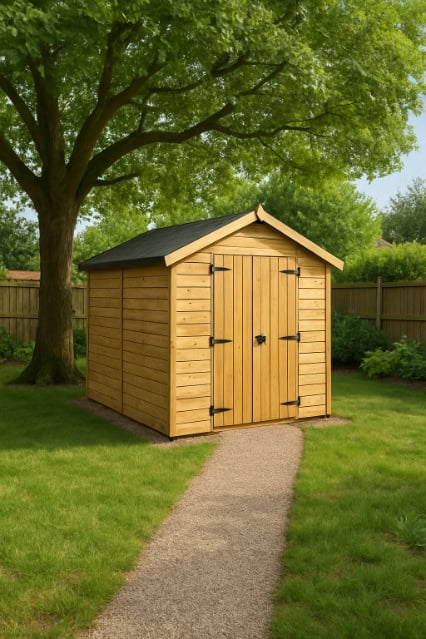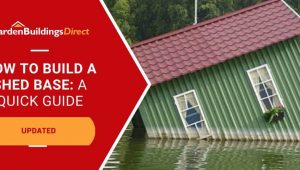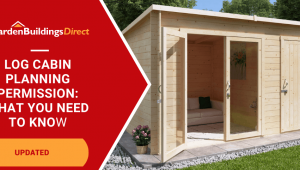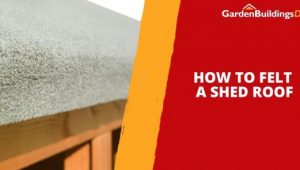Jump to:
Some gardens don’t leave many options for where a shed can go. If that’s your case and the only spot is near or under a tree, it might seem like the obvious choice. But before you commit to that spot, here’s what you need to know, so you don’t end up regretting it!
Can I Build a Shed Under a Tree?

You can, but there should be some distance between the shed and the tree (we recommend 2 feet). This is because the proximity to a tree comes with some risks. For one, trees hold moisture, drop leaves and branches, and grow in ways that can affect your shed over time. Most wooden shed manufacturers have a rule in their guarantee stipulating a distance requirement away from trees for a guarantee to remain valid.
Take into account not just the trunk but also any large branches that hang low or grow outward. Like those on oak, sycamore, or horse chestnut trees. Roots are another issue; trees might look fixed above ground, but they don’t stay in one place underground.
You don’t have to avoid trees completely, but you do need to leave enough space to avoid all these problems.
If you’re considering buying a shed and want to ensure you choose one best suited to your garden’s challenges, check out our detailed shed buying guide for expert advice on materials, sizes, and bases to keep your shed safe and lasting longer.
What Can Go Wrong If I Put My Shed Under a Tree?
These problems don’t always show up straight away, but they can lead to a daily mess and damage:
Brings more than shade
Leaves build up on the roof, block gutters, and hold water. Not to mention the bird droppings that can stain or rot the roof in the long run. Or the sap that gets sticky in summer and is hard to clean off.
Falling branches
Branches can break off in strong wind, heavy rain, or even during dry weather. A mid-sized branch can split timber, dent metal, or crack plastic panels. Even lighter ones can tear roof felt or knock trims loose.
Left alone, this kind of damage leads to leaks and warping over time. The risk only gets worse if the tree grows fast or isn’t trimmed back.
Tree roots
Roots spread out underground and can reach the base of your shed. As they grow, they start to push against it and lift parts of the structure. Even a concrete base is not immune to impact from the toughest trees or from subtle weak points. This puts pressure on the frame, shifts the floor, and can stop doors and windows from lining up properly.
Gaps may open up, and water finds its way in. Once that starts, it’s hard to fix without moving the shed.
Tree falls
Not all trees stay standing. Storms, strong winds, or unseen rot in the trunk can bring one down without warning. If a shed is too close, it won’t stand a chance—wood, metal, or plastic, none of it holds up against the weight of a full tree.
If the tree is already leaning or showing signs of damage, it’s best to keep your shed at a safe distance.
How to Make a Shed Under a Tree Work Long-Term
You can do more than just the 2-feet distance, including:
- Trimming back overhanging branches before they grow too far.
- Using a solid, raised shed base, like concrete slabs, that won’t shift if roots grow underneath.
- Checking the tree each year for signs of damage or disease.
- Keeping the roof and base free from wet leaves, bird mess, and trapped moisture.
It’s worth adding these steps to your regular garden routine. They don’t take much time, and they’ll help your shed hold up better under a tree.
FAQ
Will tree sap damage my wooden shed?
Yes, it can. Sap can soak into the timber and leave marks that are hard to remove. If the wood hasn’t been treated or painted, sap can soak in and cause marks, mould, or slow damage over time.
Can falling branches dent a metal shed?
Yes. Even medium-sized branches can leave dents or bend the panels around the roof or edges.
Does a plastic shed get damaged under a tree?
It can. Tree sap and bird mess stick to the surface and are tough to wash off once they dry. If branches fall, they may crack or stress the joints.





